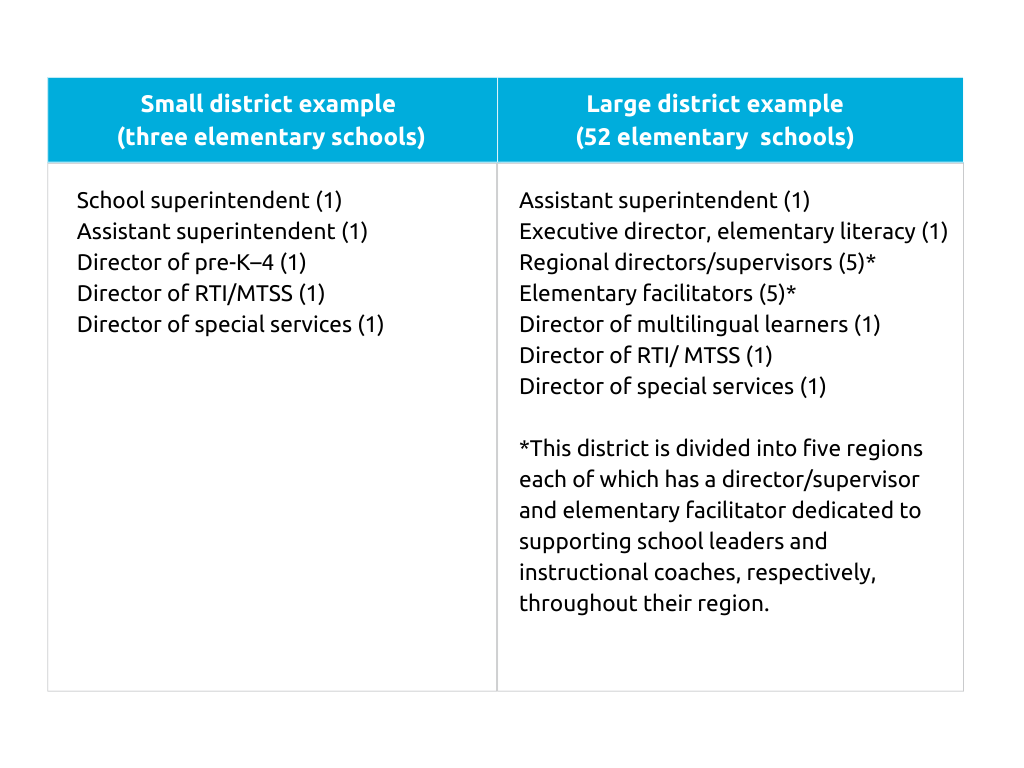
Developing Strong Readers Takes a Strong Team
If I asked a roomful of people to picture what learning to read looks like, my guess is most would conjure an image of a teacher or parent sitting with a young learner, huddled together over a book. The adult is probably helping the child sound out words, offering definitions when they stumble upon an unfamiliar one, and helping make connections to things they already know. That’s the most visible, hands-on part of the process of learning to read, so it’s natural that’s what our minds would jump to. But it’s only part of the story.
Moments like these and relationships between individual students and individual teachers are undoubtedly important, but—what’s absent from that image of an adult coaching a child—is the entire support system that teachers need in place to be able to offer high-quality reading instruction to their students.
When the early literacy team at Instruction Partners set out to understand how to systematically improve K–2 reading instruction and student outcomes throughout an entire school or district, one of our primary focuses was identifying what needs to be true of that support system in order for teachers to offer the highest quality instruction to students. We found that a strong early literacy team, composed of members of the school and district community representing a range of roles, was so crucial to catalyzing effective literacy outcomes that we identified it as one of five essential practices in early literacy.
Teams are essential because providing all students in a building or district with effective instruction is complex work, requiring interconnected strategies. Unilateral decision making and/or actions by a lone individual are unlikely to result in meaningful improvements to instruction beyond a single classroom. A coordinated network of educators is necessary to identify additional areas of needed capacity building, provide guidance for all early literacy stakeholders, and scale improvement efforts across a building or system.
Here are three steps you can take to form an early literacy team capable of catalyzing and sustaining change throughout an entire school or district.
Get organized
Your team’s makeup should be customized to your context. A team serving a single, rural school should look different than a team serving a large urban district—their staffing models, scaling requirements, accountability systems, and resource allocation will necessarily require different responsibilities and divisions of labor to meet their goals. That’s why the first things we recommend when putting a team together are 1) get clear on your field of play (e.g., an entire district or a single school within it), 2) name all the players on that field (e.g., instructional coaches, teachers, paraprofessionals, parents), and 3) begin identifying the level of involvement each of those players needs to have.
Grouping players into categories can be an effective way of beginning to determine what responsibilities best match each unique skill set. In our Early Literacy Playbook, we outline the following categories of players as a starting place:
- School and/or system leader(s): The leader(s) responsible for overseeing and orchestrating the implementation of school and/or system (i.e., district) decisions (e.g., a principal, an early literacy programming director, a superintendent).
- Early literacy team (roughly 10 people): The entire group of stakeholders that provides input on early literacy initiatives and instruction, including school and system leaders, coaches, teachers, interventionists, and coordinators of special populations (e.g., MLs).
Note: Appropriate team size may vary depending on school or district context. For instance, a team at a single, small school may decide it is able to operate more effectively and efficiently with fewer than 10 members, whereas a team at a large district may decide more than 10 members are necessary to ensure that all relevant stakeholders are well coordinated. Here’s an example of how one of our small and large district partners composed their early literacy teams.

In both districts, these early literacy teams were responsible for communicating with and delegating responsibilities to important stakeholders at the school level, including principals (one per school), assistant principals (one per school), and instructional coaches (one per school).
- Early literacy leadership team (roughly three people): A subset of early literacy team members that is responsible for ensuring that early literacy initiatives are implemented effectively and continuously improving, makes recommendations to school/system leaders, and leads the early literacy team.
- Early literacy stakeholders: All members of the school community responsible for supporting students in K–2 literacy, including—but not limited to—instructional coaches, district team members, educational assistants, early literacy educators, and the early literacy team.
- Early literacy educators: All teachers responsible for facilitating early literacy instruction to students in grades K–2 (e.g., classroom teachers, ML and SPED teachers, early literacy interventionists).
Taking a look at the roles you currently have and noting who needs to be involved in your early literacy team in order to meet the needs of your specific context is the first step toward creating a coalition that can set and work toward early literacy goals in your school or district.
Get specific
It’s all very well and good to say that the principal is “responsible for overseeing and orchestrating the implementation of school…decisions,” but what does that actually mean for someone’s day-to-day work?
Understanding the different roles stakeholders play in your early literacy system at a high level is a starting point, but—usually—people need a more granular understanding of what they’re responsible for in order to fill their roles effectively. Assigning specific roles, specific responsibilities is key to moving the needle on student outcomes.
Before narrowing in on the specifics, it’s important to focus in on exactly where it is you’re going. One of the first things your team will do is create your vision for early literacy. That vision can serve as your anchor for drilling down into the specific responsibilities of your team. Map what needs to be true to achieve your vision, and assign creating and/or maintaining those conditions as responsibilities to the roles you identified within your early literacy system. See an example here.
As you go through this process, it’s important to focus on the resources you have rather than the staffing model of your dreams. It’s always tempting to play the “if only we had a role for x here” game. Advocating for needed capacity is important, but getting creative with the resources you already have can lead to massive results and build buy-in for your team’s early literacy vision. Which brings us to…
Get close
One of the most effective ways we’ve seen schools and districts use their teams to improve early literacy results is by getting administrators and other staff members out of the office, library, or gym and into the classroom. This push-in model does two key things:
- Provides classroom teachers with support they need to provide effective small-group instruction to every member of their class. Classroom teachers can only be in one place at a time—and therefore only work with one group of students at a time. Preparing non-teaching staff to work directly with individual or small groups of students—or to oversee and support students while they complete independent work—frees the teacher to dedicate their full attention to particular needs of one small group of students. Not only does this ensure that students receive support tailored to their needs, but it provides them with more direct instructional time with educators—which our experience in classrooms indicates produces outsized learning gains.
- Invests your school or district team deeply in early literacy initiatives by letting them be involved in the day-to-day work of teaching a child to read and the joy of seeing them make progress. This hands-on approach helps build and sustain buy-in through the long and, at times, challenging process of implementing systemic change—which reinventing a school’s or district’s early literacy system requires.
Check out an example of this small-group model in action and hear testimonials from administrators and support staff who provided push-in supports here.
Assembling your team, getting clear on what you need from all players in the early literacy system, and keeping yourself and your early literacy stakeholders directly involved in students’ journey toward becoming proficient readers and writers are essential steps in creating strong early literacy structures and strategies in your school or system.
As you get deeper into the work, assigning not only specific responsibilities to specific roles but specific actions to specific individuals can be a real game changer for improving early literacy outcomes. That’s why we designed our Early Literacy Playbook around specific, step-by-step actions—complete with suggestions of which stakeholder group should be responsible for each—that are easily customizable to the unique needs of school and system teams. Get started today!


